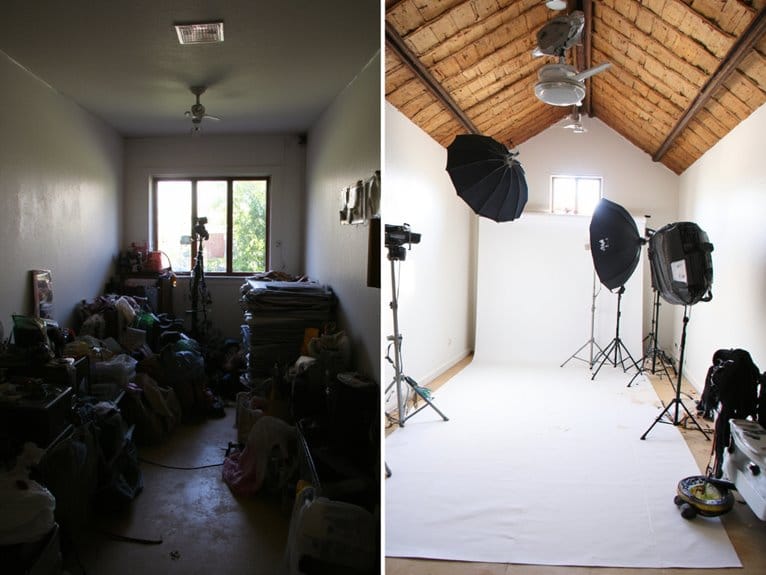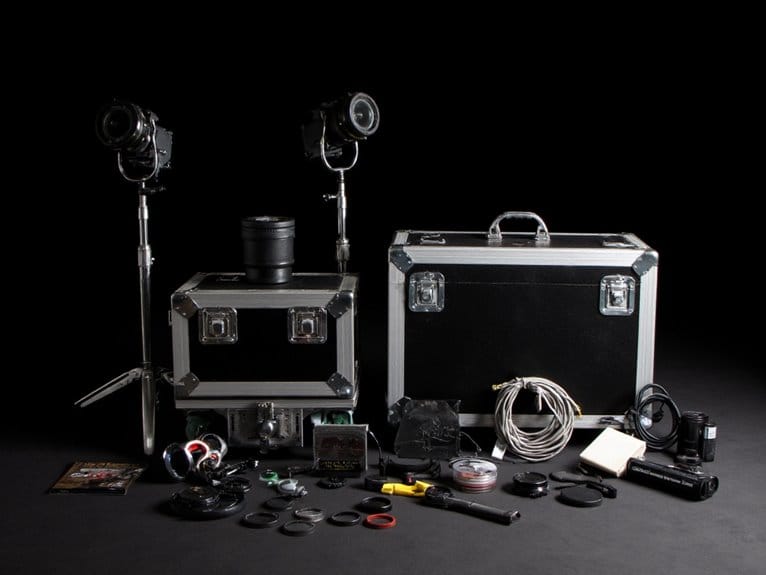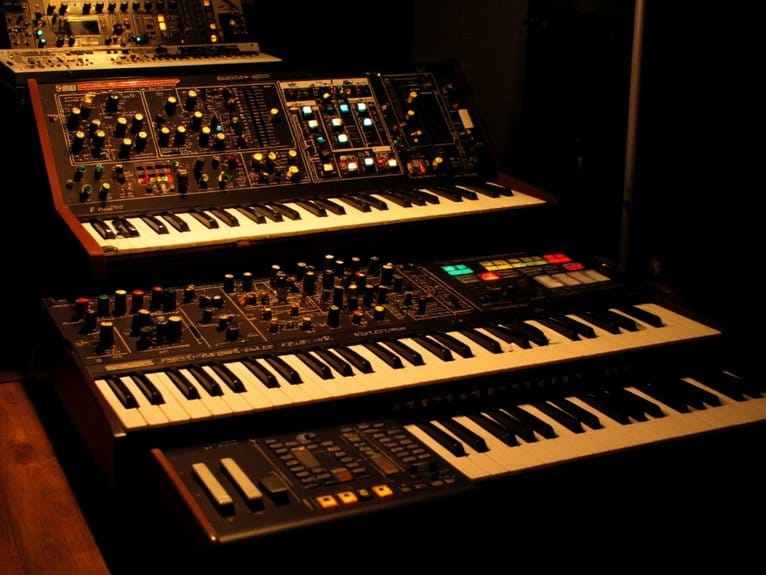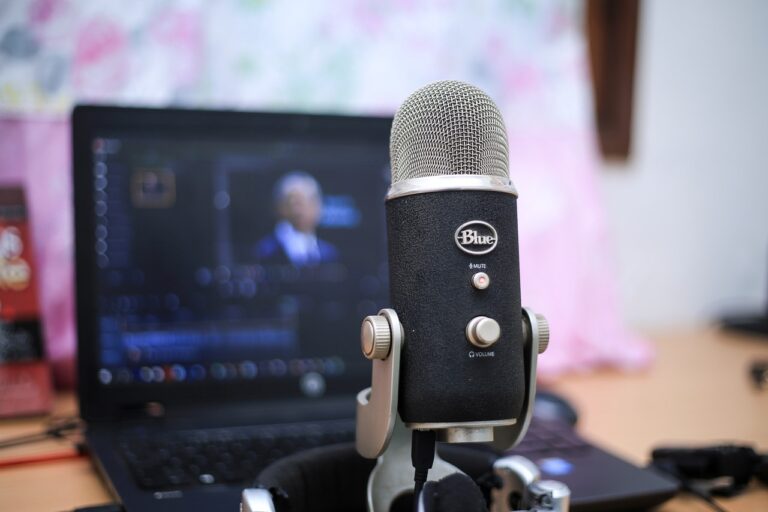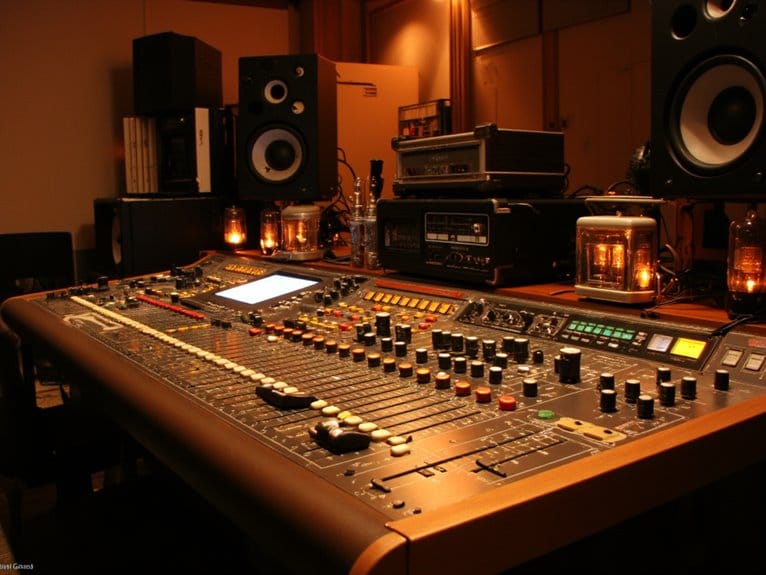Studio Expansion Guide: When and How to Upgrade
When your studio consistently hits 85% occupancy rates while clients complain about overcrowding and equipment storage overflows, you’re ready to expand into the creative industries’ projected $4.24 trillion market by 2033. Start by creating a 3-5 year master plan that accommodates double your current capacity, focusing on scalable infrastructure like cloud-based systems, professional audio interfaces with 24-bit/192kHz capabilities, and modular power distribution with 20-30% expansion margins. Strategic planning guarantees your investment captures emerging opportunities.
We are supported by our audience. When you purchase through links on our site, we may earn an affiliate commission, at no extra cost for you. Learn more.
Notable Insights
- Expand when occupancy rates consistently exceed 85% and client feedback indicates overcrowding or equipment storage limitations.
- Develop a 3-5 year strategic master plan with growth milestones, revenue targets, and infrastructure accommodating double current capacity.
- Assess current equipment against future production demands, prioritizing professional audio interfaces and scalable technology systems with cloud-based solutions.
- Plan power distribution with 20-30% expansion margin beyond peak demand and implement dedicated circuits for audio equipment.
- Categorize expenses into fixed, variable, and periodic costs while building multiple revenue streams for financial stability during expansion.
Recognizing the Right Time to Expand Your Studio Space
Several key indicators can help you determine when it’s the right time to expand your studio space, and I’ve learned that recognizing these signals early makes the difference between a strategic growth move and a reactive scramble.
Market trends reveal compelling growth patterns, with coworking spaces adding nearly 4 million square feet nationally in early 2025, while social media advertising sales climb 6% annually, driving content production demands.
Your capacity analysis should focus on utilization rates during peak hours, client feedback about overcrowding, and scheduling conflicts that limit operational flexibility.
I’ve found that sustained revenue growth, coupled with occupancy rates consistently hitting 85% or higher, typically signals readiness for expansion, especially when equipment storage strains your current footprint.
Creating a Strategic Master Plan for Growth
When you’re ready to scale your studio beyond its current limitations, you’ll need to create projections that account for client growth, revenue targets, and market expansion over the next three to five years.
I’ve learned that successful studios don’t just plan for immediate needs-they build infrastructure that can handle double or triple their current capacity, incorporating scalable technology systems, flexible workspace configurations, and operational processes that won’t break under increased demand.
Your master plan should map out specific growth milestones, equipment upgrades, and staffing requirements that align with projected client acquisition rates, ensuring you’re not scrambling to catch up when opportunities arrive. Consider implementing ADAT compatibility in your core systems to provide seamless expansion pathways as recording demands increase.
Part of this infrastructure planning involves selecting audio interfaces with expandable input channels and professional features that can accommodate increasingly complex recording sessions as your studio grows.
Future Growth Projections
As you develop your studio’s strategic master plan for growth, the numbers paint a compelling picture of opportunity that I’ve watched unfold across the creative industry landscape.
Market trends indicate the global creative industries will expand from $3.03 trillion in 2025 to $4.24 trillion by 2033, delivering a steady 4.29% CAGR that’s frankly more reliable than I initially expected.
Your industry analysis should focus on the creative management platform segment, which I’ve seen accelerate at 8.1% annually, reaching $2.07 billion by 2032. Design agencies aren’t lagging either, projected to grow from $2.3 billion to $3.7 billion through 2031.
With U.S. advertising revenue hitting $363 billion this year alone, you’re positioning yourself within an ecosystem that’s consistently expanding across digital media, personalized content, and AI-driven automation.
Scalable Infrastructure Planning
Building on these promising market projections, I’ve learned that translating growth potential into operational reality requires infrastructure that can flex and expand without breaking your budget or your sanity.
Your scalable architecture must anticipate future demands, incorporating modular solutions that grow incrementally rather than requiring massive overhauls every few years.
I recommend establishing clear performance benchmarks, evaluating your current systems for bottlenecks, and prioritizing cloud-based solutions that offer flexible capacity scaling.
Cross-departmental collaboration guarantees your infrastructure vision aligns with operational needs, while microservices architecture provides the independent scalability units you’ll need during expansion phases.
Proper growth alignment between technology investments and business objectives creates a sustainable foundation that adapts naturally to market shifts. Planning for upgrade potential allows you to enhance your studio setup over time without losing previous recordings or disrupting existing workflows.
When planning your studio’s audio equipment infrastructure, consider combination mixer/audio interface units that provide budget-friendly solutions for both recording and live mixing needs as your requirements evolve.
Designing Efficient Layouts That Support Continuous Operations
Once you’ve determined your studio’s overall footprint and acoustic requirements, the real challenge becomes creating a layout that won’t force your team to constantly interrupt each other’s work. Effective layout optimization starts with implementing the “dead-end live-end” strategy, positioning instruments at the rear while placing mixing stations forward to minimize sound bleed. Your acoustic treatment approach should differ between zones-live rooms need controlled reflections while mixing areas require precise monitoring environments.
| Zone Type | Primary Function | Key Design Elements |
|---|---|---|
| Live Recording | Instrument capture | Diffusion panels, controlled reverb |
| Control Room | Mixing/monitoring | Absorption treatment, ergonomic positioning |
| Isolation Booth | Vocal recording | Full acoustic separation, sight lines |
| Equipment Area | Technical operations | Ventilation, cable management systems |
| Collaboration Space | Client interaction | Comfortable seating, visual access |
Smart ergonomic design guarantees your workflow efficiency remains high during those inevitable 12-hour sessions. When selecting headphone amplifiers for your monitoring setup, ensure proper impedance matching between your headphones and amplifiers to maintain optimal sound quality throughout extended sessions. Additionally, proper placement of microphone preamp stations throughout your live recording areas ensures optimal signal amplification without requiring excessive cable runs that could introduce noise or signal degradation.
Equipment Selection and Technical Infrastructure Planning
When you’re expanding your studio, you’ll need to evaluate your current equipment against future production demands, ensuring each piece can handle the workflows you’re planning three to five years down the road.
Your technical infrastructure becomes the backbone that supports everything from high-resolution video processing to real-time collaborative editing, requiring careful planning of power distribution, network capacity, and cooling systems that won’t buckle under increased loads.
I’ve seen too many studios rush into equipment purchases without properly appraising their electrical and data requirements first, which typically leads to expensive retrofits and frustrating bottlenecks that could’ve been avoided with upfront infrastructure planning.
Audio interfaces represent a critical component of this infrastructure evaluation, requiring specifications like 24-bit/192kHz resolution and multiple input/output configurations to support professional streaming and recording workflows without limiting your studio’s growth potential. Professional interfaces like those from RME offer daisy-chaining capabilities that allow you to expand channel counts as your studio requirements grow over time.
Current Equipment Assessment
Before you can effectively plan your studio’s next phase of growth, I’ve learned that conducting a thorough assessment of your current equipment becomes the foundation for every smart expansion decision you’ll make. Your equipment evaluation should start with creating a detailed inventory of microphones, interfaces, monitors, and cables, noting each item’s condition and performance history.
I recommend systematic functionality testing of every component, checking for distortion, noise, or connectivity issues that could impact your workflow.
Don’t overlook the basics-inspect cables for wear, verify firmware updates, and test signal routing throughout your chain. During this assessment, verify that your impedance matching between microphones and preamps follows the ten-to-one rule to prevent signal loss and maintain optimal performance.
This methodical approach reveals which gear truly serves your needs versus what’s simply taking up rack space, helping you prioritize upgrades intelligently. Pay special attention to your microphone collection’s frequency response specifications, ensuring they meet the professional standard of 20Hz-20kHz for optimal audio capture across all recording scenarios.
Future-Ready Technical Systems
While your current equipment assessment reveals what you’ve got today, building future-ready technical systems requires a completely different mindset-one that anticipates where your studio will be in three to five years, not just next month.
I’ve learned that sustainable technology choices start with Intel-based, 64-bit CPUs supporting virtualization, paired with at least 8 GB RAM for complex applications like Oracle GoldenGate Studio.
You’ll need Windows 10 (64-bit) or macOS Mojave minimum, plus storage ranging from 3.5 GB to 500 GB depending on scalability needs.
Innovation trends point toward dual quad-core processors handling middleware like Oracle Fusion Middleware, while maintaining compatibility with frameworks like .NET 4.8 and JDK versions.
Smart infrastructure planning means designing for memory expansion, network stability, and modular upgrades that won’t break your budget.
Consider USB-C connectivity for future compatibility, as modern interfaces increasingly adopt this standard for better device integration and improved data transfer speeds.
Professional audio interfaces with 24-bit recording capabilities ensure your technical infrastructure can handle studio-grade audio processing as your production demands grow.
Power and Data Infrastructure
Since your studio’s future depends entirely on its power backbone, I’ve discovered that most expansion failures stem from underestimating electrical infrastructure demands by at least 40%, creating costly bottlenecks that’ll cripple your growth before it starts.
Your power distribution system needs a 20-30% expansion margin beyond current peak demand, while network optimization requires careful consideration of data flow patterns. I’ve seen studios struggle with inadequate wiring calculations, particularly when amperage increases overwhelm existing panel boards.
| Infrastructure Component | Power Requirements | Network Impact |
|---|---|---|
| Studio Equipment | 60% of total load | High bandwidth |
| HVAC Systems | 25% of total load | Minimal data |
| Network Hardware | 5% of total load | Critical uptime |
| Emergency Backup | 10% reserve capacity | Redundant paths |
Modular power towers and fiber optic cabling provide scalable solutions without complete overhauls. When planning your electrical layout, remember that audio interfaces require dedicated power circuits to maintain their superior analog-to-digital conversion capabilities and minimize noise interference that could compromise your recording quality. Consider implementing self-powered units for critical recording stations since they utilize external adapters providing over 22 watts and deliver superior audio quality compared to bus-powered alternatives that compete for limited power resources.
Building Your Team to Match Your Expanded Capacity
As your studio’s physical footprint grows and new opportunities emerge, the foundation of sustainable expansion doesn’t lie in square footage or equipment alone-it rests entirely on assembling the right people with complementary skills, shared values, and genuine enthusiasm for collaborative growth.
Strategic scaling requires you to define roles precisely, ensuring skill alignment matches your expanded capacity needs. Focus on team dynamics by grouping members whose abilities complement each other, creating balanced units that optimize workflow naturally.
You’ll want to establish clear onboarding processes for different departments, maintaining consistency while empowering “scale champions” who keep growth objectives front and center.
Managing Finances and Mitigating Expansion Risks
When your studio team’s finally clicking and workspace expansion feels tantible, frankly, the financial reality check hits harder than most entrepreneurs expect-and I’ve watched talented creatives stumble here more often than anywhere else in the growth process. You’ll need robust financial forecasting that categorizes expenses into fixed, variable, and periodic costs while developing seasonal budget variations to reflect natural business cycles. Expense tracking becomes critical as you monitor monthly inflows and outflows, ensuring expenses don’t exceed income through careful allocation and strategic cost-cutting.
| Expense Category | Monthly Budget | Growth Impact |
|---|---|---|
| Fixed Costs | $3,000-5,000 | Low flexibility |
| Variable Costs | $1,500-4,000 | Scales with revenue |
| Periodic Investments | $2,000-8,000 | High growth potential |
Build multiple revenue streams and maintain cash flow buffers to handle unforeseen expansion challenges effectively.
Frequently Asked Questions
What Permits and Zoning Approvals Are Needed Before Starting Studio Construction?
You’ll need building permits for the structure itself, plus electrical, mechanical, and plumbing permits for any system work.
Before applying, secure zoning approvals to guarantee your project complies with local zoning regulations regarding building type, size, and land use.
I’d recommend coordinating with your city’s planning department first, since zoning reviews typically precede construction permits and can prevent costly delays later.
How Do I Handle Client Communication During Temporary Service Disruptions?
You’ll want to establish clear client notifications immediately when disruptions occur, acknowledging the issue honestly while providing specific timelines for resolution.
I’ve found that sending service updates through multiple channels-email, SMS, and status pages-ensures everyone stays informed, though consistency across platforms remains essential.
Schedule regular updates every hour, even without major developments, because clients appreciate knowing you’re actively working on solutions.
Should I Hire a Project Manager or Oversee the Expansion Myself?
You’ll want to conduct a thorough cost benefit analysis comparing a project manager’s salary against potential overruns from self-management, especially since poor oversight wastes 12% of resources.
Your timeline evaluation should consider whether you can realistically coordinate 6-10 team members while maintaining core operations.
If your expansion’s complex or you lack project management experience, hiring professionals typically prevents the 10% financial losses from underperformance.
What Insurance Coverage Changes Are Required for Expanded Studio Operations?
You’ll need to upgrade your liability coverage greatly since expanded operations increase third-party injury risks.
Your property insurance must cover additional equipment, locations, and higher asset values.
Workers’ compensation adjustments are mandatory for new hires, while cyber liability becomes essential if you’re adding digital operations.
I’d recommend reviewing coverage limits with your agent, as basic policies won’t adequately protect larger studio operations.
How Can I Maintain Brand Consistency Across Multiple Studio Locations?
You’ll need thorough brand guidelines covering logos, colors, messaging, and visual elements to protect your brand identity across locations.
I’ve found that centralized digital resources work best for keeping materials consistent while allowing controlled local flexibility.
Your marketing strategy should include standardized templates, regular team training, and collaborative platforms that connect all studios.
Monitor brand recognition metrics consistently, adapt messaging for local relevance without diluting core values, and conduct regular audits to prevent unauthorized brand variations.
On a final note
You’ve got the roadmap now-timing your expansion correctly, crafting that strategic plan, optimizing your layout for workflow efficiency, selecting equipment that’ll actually serve your needs, and building a team that can handle increased capacity. I’ve learned the hard way that financial planning isn’t glamorous, but it’s what separates successful expansions from expensive mistakes. Trust the process, stay methodical, and you’ll scale sustainably.

